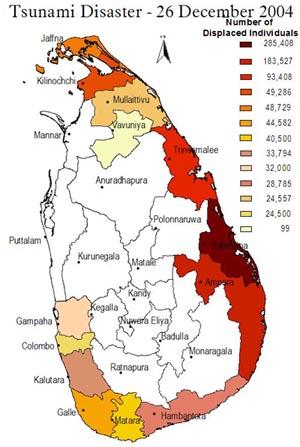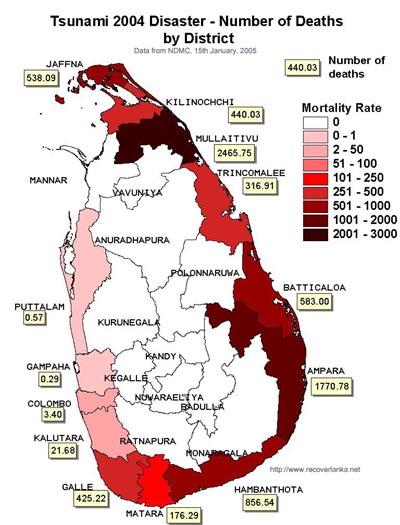Hazard Analysis Table
The hazard analysis table shows that the highest priority hazard in Sri Lanka, as detected through the analysis, is Earthquake (seismic activity) or Tsunami. The reason for this choice is for three factors.
First, this natural disaster has caused the biggest damage to the country. Even though it occurred only once in 2004, it has caused more deaths and affected more lives than any other natural hazard.
Second, this natural disaster has caused the greatest cost in terms of human life and infrastructural damage in the country.
Third, an earthquake cannot be predicted earlier, and can only be detected when it occurs . Therefore, the level of preparedness to prevent or take precautionary measures is very low in case of a seismic earthquake. Therefore, the priority of this particular hazard should be the most.
The second natural hazard in the priority rating is flooded. In the last thirty years, Sri Lanka has experienced 45 floods.
The sheer frequency of occurrence of the disaster shows that it is almost an annual event and therefore, requires a high degree of preparedness on the part of the country to counter it.
The degree of human loss due to floods is not very high when compared to Tsunami, but due to their regular occurrence, it affects many lives. In the last thirty years, 9982031 people have been affected due to floods . Therefore, the priority ranking of this hazard is two.
The third-ranked disaster is droughts. The reason for its higher rank compared to mass movement wet, epidemic, and the storm is due to its high cost.
There have been four droughts in the country in last 30 years, but the cost of the disaster has been ranked first with the average cost being highest in 30 years ($1451500 thousand per disaster).
Such high material damage to the country is a great loss and therefore requires a high degree of attention from the disaster management department of the country.
The epidemic is ranked the fourth most important disaster, above mass movement wet and storms, because it has occurred seven times and has affected more people in the country than the other two natural hazards .
Earthquake (seismic activity)
The high priority disaster that is chosen for future and present essay is Earthquake (seismic activity).
This section will discuss earthquakes (seismic activity) concerning the areas in the country that are most earthquake-prone, the probability of occurrence of the disaster, and an explanation as to why certain areas in the country are most vulnerable to the disaster.
Sri Lanka lies very close to the highly active seismic zone in South-east Asia and Sumatra, even though it lies away from the plate boundaries.
The country’s proximity to the active seismic zone of South-east Asia makes it vulnerable to Tsunami hazard if the area above experiences earthquake. Tsunami has occurred twice in the country – once in 1883 which was caused by a volcanic eruption in Indonesia and then in 2004 .

The impact to a seismic earthquake is expected to affect the coastal regions of Sri Lanka more, especially the regions of Kilinochchi to Puttalam.
Figure 1 demonstrates the regions in the country that was worst affected by the 2004 Tsunami, and therefore it can be deduced that the eastern coastal belts of Sri Lanka would be worst affected if another tsunami occurs.
The areas of the country that had been worst affected were Batticaloa, Ampara, Trincomalee, Kilinochchi, and Jafna.
The areas where the maximum number of deaths has occurred due to the 2004 Tsunami is shown in figure 2.

Deaths have been extremely high in the coastal areas of Sri Lanka. Death tolls have been highest in the eastern coastal districts of Mullaitivu, Ampara, and Hambanthota.
The eastern coast of the country faced the maximum impact of the seismic earthquake because the epicenter of the earthquake was in South-east Asia and therefore, was closest to the source of the disaster.
Further, as the region of Sumatra and South-East Asia are near the eastern coast of Sri Lanka, an earthquake occurring in that part of the continent would surely affect this region.
Further, the southeastern coast of the country is a tourist spot as well as an activist for anglers, therefore, caused a high death toll. The southwestern coast also faced a high number of deaths but not as many as seen in the southeastern parts of the country.
Another cause of concern for the country is the recent report demonstrating that the Indo-Australian plate lying 500-700 km off the southwest coast of Sri Lanka is splitting, increasing concern over another Tsunami or earthquake in the western coasts also.
Therefore, the risk of an earthquake in the country is very high.
References
Columbia University. (2013). Disaster Management. Web.
Dissanayake, C. (2013). Earthquakes and tsunamis: How vulnerable is Sri Lanka? Web.
EM-DAT. (2013). Country Profile. Web.
Helgeson, T. (2013). Tsunami Disaster in Sri Lanka. Web.